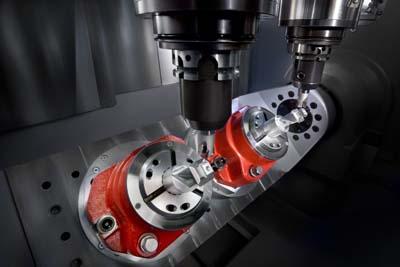
DZ 12K S MAGNUM five axis from Chiron America Inc. is a double-spindle, highly productive, 5-axis complete machining center with 2-axis tilt rotary table for milling and turning complex workpieces in one set-up. The possibility of complete machining in a single set-up reduces the total machining time and the costs per piece, simplifies material flows and allows customers to manufacture with less staff. Compared to the single-spindle solution, DZ 12K S MAGNUM five axis doubles the productivity while saving up to 30 percent in energy costs at the same time.Compared to multiple-stage manufacturing strategies, a significant advantage of 5-axis machining lies in the improved surface quality and geometric accuracy. Direct path measurement systems in all axes are standard equipment in all CHIRON 5-axis centers. When using CHIRON double-spindle machining centres together with a 2-axis tilt rotary table and modern high-performance tools, users achieve multiple performance increases. The initiative for developing the DZ 12K S MAGNUM five axis came from CHIRON customers within the scope of turnkey projects, which demanded a compact solution, standing for top productivity with minimum floor space requirement, and, as an overall system, works reliably and energy-efficiently. Dr. Dirk Prust, the Managing Director of Sales, Technology and Service of Chiron-Werke GmbH & Co KG, Tuttlingen: "The trend toward more complex series workpieces is clearly continuing. With 5-axis machining, higher precision is achievable, since reclamping isn't necessary, for example. To meet the productivity demands of such series workpieces, we have implemented these requirements in a cost-effective double-spindle machining center. DZ 12K S MAGNUM 5 axis has the proven advantages of CHIRON double-spindle centers, as the lower floor space and personnel requirements, the reduction of the cost per part by reducing the total machining time, and, compared to the single-spindle solution, double the productivity while saving up to 30 percent in energy costs at the same time." Another feature of the new machining center is the reinforced tool taper to HSK-A 63, which will be available starting immediately for the entire CHIRON 12 series. The 2-axis tilt rotary table, developed and produced in-house, stands for high precision and extraordinary stability. In conjunction with the reinforced tool taper and the powerful spindle with a max. speed of 24,000 rpm, a top surface quality can be achieved. Furthermore, the rotary axes, driven by torque motors, allow simultaneous turning operations at 1,000 rpm, ideal for complex complete machining. The X, Y and Z travel is 550, 400 and 360mm, allowing sufficient room for positioning and machining complex workpieces made of steel, cast iron, aluminium or titanium. The axis accelerations are 10, 15 and 15 m/s², and the rapid feeds in all linear axes reach max. 75 m/min. The machine is also prepared for robot automation with the cost-effective standard module FlexCell Uno.
Contact Details
Related Glossary Terms
- centers
centers
Cone-shaped pins that support a workpiece by one or two ends during machining. The centers fit into holes drilled in the workpiece ends. Centers that turn with the workpiece are called “live” centers; those that do not are called “dead” centers.
- gang cutting ( milling)
gang cutting ( milling)
Machining with several cutters mounted on a single arbor, generally for simultaneous cutting.
- machining center
machining center
CNC machine tool capable of drilling, reaming, tapping, milling and boring. Normally comes with an automatic toolchanger. See automatic toolchanger.
- milling
milling
Machining operation in which metal or other material is removed by applying power to a rotating cutter. In vertical milling, the cutting tool is mounted vertically on the spindle. In horizontal milling, the cutting tool is mounted horizontally, either directly on the spindle or on an arbor. Horizontal milling is further broken down into conventional milling, where the cutter rotates opposite the direction of feed, or “up” into the workpiece; and climb milling, where the cutter rotates in the direction of feed, or “down” into the workpiece. Milling operations include plane or surface milling, endmilling, facemilling, angle milling, form milling and profiling.
- turning
turning
Workpiece is held in a chuck, mounted on a face plate or secured between centers and rotated while a cutting tool, normally a single-point tool, is fed into it along its periphery or across its end or face. Takes the form of straight turning (cutting along the periphery of the workpiece); taper turning (creating a taper); step turning (turning different-size diameters on the same work); chamfering (beveling an edge or shoulder); facing (cutting on an end); turning threads (usually external but can be internal); roughing (high-volume metal removal); and finishing (final light cuts). Performed on lathes, turning centers, chucking machines, automatic screw machines and similar machines.
